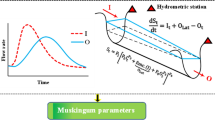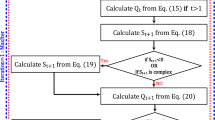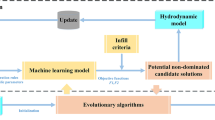Abstract
Considering the great importance of flood prediction, flood routing based on Shark Algorithm (SA) and Four-Parameter Nonlinear Muskingum (FPNM) has been proposed in the present study. In fact, the Muskingum model is considered as one the most efficient method for predicting flood. However, to successfully implement Muskingum Model, there is a need to compute various parameters of this model utilizing a lot of data that characterized the physical features of the catchment. Therefore, there is a need to integrate the Muskingum model with an optimization method. Nevertheless, there are several drawbacks including trap** in local optima, overhead response and convergence time-consuming have been experienced using the existing optimization methods. Therefore, in this study, a proposal for utilizing an integrated evolutionary computing method namely; SA with FPNM has been introduced to overcome such drawbacks. Three case studies based on the definition of objective functions and different error indices were used to evaluate the algorithm. The results showed that SA significantly reduced the sum of the total square deviations (SSQs) and the sum of absolute deviation (SAD) between the predicted and observed discharges compared to other evolutionary algorithms. Moreover, the proposed model achieved high ability to accurately determine the peak value and peak time of the discharge. In addition, the calculated hydrodynamic shape has a high correlation with observed hydrographs.








Similar content being viewed by others
References
Ahmed AN, Othman FB, Afan HA, Ibrahim RK, Fai CM, Hossain MS et al (2019) Machine learning methods for better water quality prediction. J Hydrol 578:124084
Asgari HR, Bozorg-Haddad O, Loáiciga HA (2017) Closure to “parameter estimation of extended nonlinear Muskingum models with the weed optimization algorithm” by Farzan Hamedi, Omid Bozorg-Haddad, Maryam Pazoki, Hamid-Reza Asgari, Mehran Parsa, and Hugo a. Loáiciga. J Irrig Drain Eng 144(1):07017022
Barati R, Badfar M, Azizyan G, Akbari GH (2017) Discussion of “parameter estimation of extended nonlinear Muskingum models with the weed optimization algorithm” by Farzan Hamedi, Omid Bozorg-Haddad, Maryam Pazoki, Hamid-Reza Asgari, Mehran Parsa, and Hugo a. Loáiciga. J Irrig Drain Eng 144(1):07017021
Barati R (2017) Comment on “evaluation of a physically based quasi-linear and a conceptually based nonlinear Muskingum methods”. J Hydrol 550:218–219. https://doi.org/10.1016/j.jhydrol.2017.01.025
Das A (2004) Parameter estimation for Muskingum models. J Irrig Drain Eng 140–147
Easa S (2013) New and improved four-parameter non-linear Muskingum model. Proc ICE-Water Manag:1–3
Ehteram M, Karami H, Mousavi SF, El-Shafie A, Amini Z (2017a) Optimizing dam and reservoirs operation based model utilizing shark algorithm approach. Knowl-Based Syst 122:26–38
Ehteram M, Karami H, Mousavi SF, Farzin S, Kisi O (2017b) Evaluation of contemporary evolutionary algorithms for optimization in reservoir operation and water supply. J Water Supply: Res Technol-Aqua, jws2017109
Ehteram, M., El-Shafie, A. H., Hin, L. S., Othman, F., Koting, S., Karami, H., ... & Hafiz, M. (2019). Toward bridging future irrigation deficits utilizing the shark algorithm integrated with a climate change model. Appl Sci 9(19), 3960
Gill MA (1978) Flood routing by the Muskingum method. J Hydrol 36(3–4):353–363
Haddad OB, Hamedi F, Fallah-Mehdipour E, Orouji H, Mariño MA (2015) Application of a hybrid optimization method in Muskingum parameter estimation. J Irrig Drain Eng 141(12):04015026
Hamedi F, Bozorg-Haddad O, Pazoki M, Asgari HR, Parsa M, Loáiciga HA (2016) Parameter estimation of extended nonlinear Muskingum models with the weed optimization algorithm. J Irrig Drain Eng 142(12):04016059
Kang L, Zhang S (2016) Application of the elitist-mutated PSO and an improved GSA to estimate parameters of linear and nonlinear Muskingum flood routing models. PLoS One 11(1):e0147338
Kang L, Zhou L, Zhang S (2017) Parameter estimation of two improved nonlinear Muskingum models considering the lateral flow using a hybrid algorithm. Water Resour Manag 31(14):4449–4467
Karahan H, Gurarslan G, Geem ZW (2012) Parameter estimation of the nonlinear Muskingum flood-routing model using a hybrid harmony search algorithm. J Hydrol Eng 18(3):352–360
Kim JH, Geem ZW, Kim ES (2001) Parameter estimation of the nonlinear Muskingum model using harmony search. JAWRA J Am Water Resour Assoc 37(5):1131–1138
Moghaddam A, Behmanesh J, Farsijani A (2016) Parameters estimation for the new four-parameter nonlinear Muskingum model using the particle swarm optimization. Water Resour Manag 30(7):2143–2160
Mohan S (1997) Parameter estimation of nonlinear Muskingum models using genetic algorithm. J Hydraul Eng 123(2):137–142
Niazkar M, Afzali SH (2014) Assessment of modified honey bee mating optimization for parameter estimation of nonlinear Muskingum models. J Hydrol Eng 20(4):04014055
Ouyang A, Li K, Truong TK, Sallam A, Sha EHM (2014a) Hybrid particle swarm optimization for parameter estimation of Muskingum model. Neural Comput & Applic 25(7–8):1785–1799
Ouyang A, Tang Z, Li K, Sallam A, SHA E (2014b) Estimating parameters of Muskingum model using an adaptive hybrid PSO algorithm. Int J Pattern Recognit Artif Intell 28(01):1459003
Viessman W, Lewis GL (2003) Introduction to hydrology. Pearson Education Inc., Upper Saddle River
Tung Y-K (1985) River flood routing by nonlinear Muskingum method. J Hydraul Eng 111:1447–1460
Yaseen Z, Ehteram M, Sharafati A, Shahid S, Al-Ansari N, El-Shafie A (2018) The integration of nature-inspired algorithms with least square support vector regression models: application to modeling river dissolved oxygen concentration. Water 10(9):1124
Yousif AA, Sulaiman SO, Diop L, Ehteram M, Shahid S, Al-Ansari N, Yaseen ZM (2019) Open channel sluice gate scouring parameters prediction: different scenarios of dimensional and non-dimensional input parameters. Water 11(2):353
Wilson EM (1974) Engineering hydrology. Macmillan Education, Hampshire
Yahya A, Saeed A, Ahmed AN, Binti Othman F, Ibrahim RK, Afan HA et al (2019) Water quality prediction model based support vector machine model for Ungauged River catchment under dual scenarios. Water 11(6):1231
Yoon J, Padmanabhan G (1993) Parameter estimation of linear and nonlinear Muskingum models. J Water Resour Plan Manag 119(5):600–610
Author information
Authors and Affiliations
Corresponding author
Ethics declarations
Conflict of Interest
None.
Additional information
Publisher’s Note
Springer Nature remains neutral with regard to jurisdictional claims in published maps and institutional affiliations.
Rights and permissions
About this article
Cite this article
Farahani, N., Karami, H., Farzin, S. et al. A New Method for Flood Routing Utilizing Four-Parameter Nonlinear Muskingum and Shark Algorithm. Water Resour Manage 33, 4879–4893 (2019). https://doi.org/10.1007/s11269-019-02409-2
Received:
Accepted:
Published:
Issue Date:
DOI: https://doi.org/10.1007/s11269-019-02409-2




